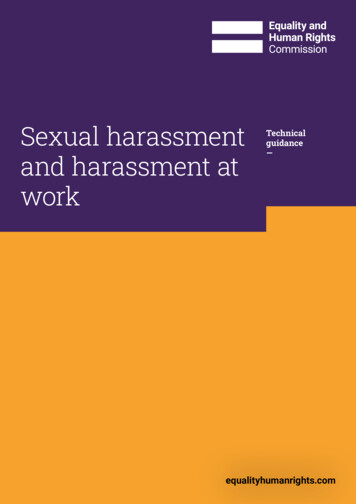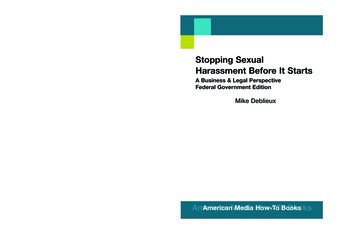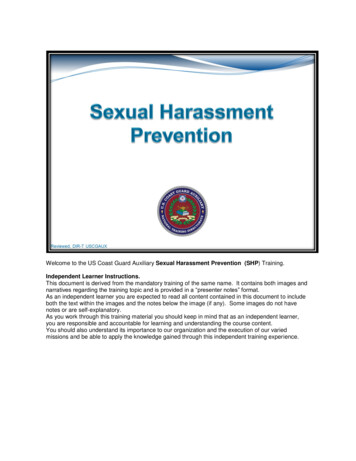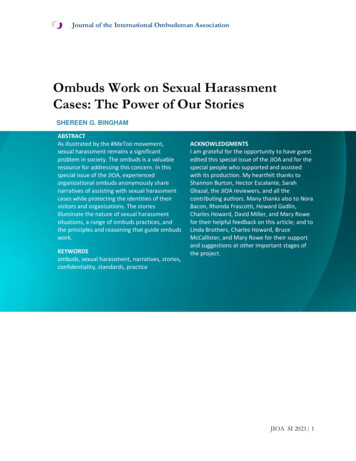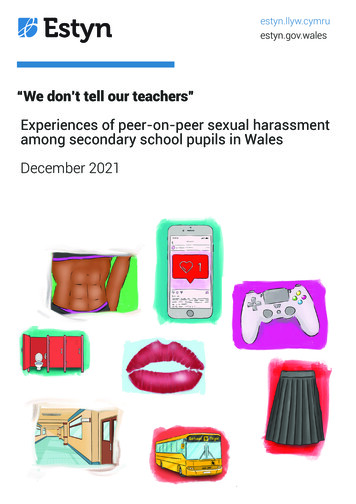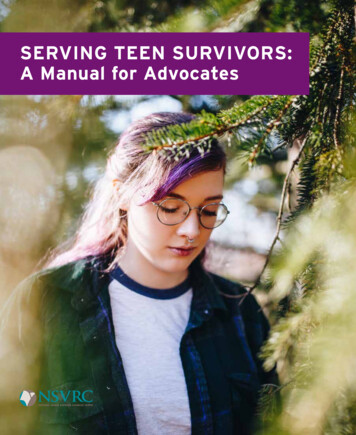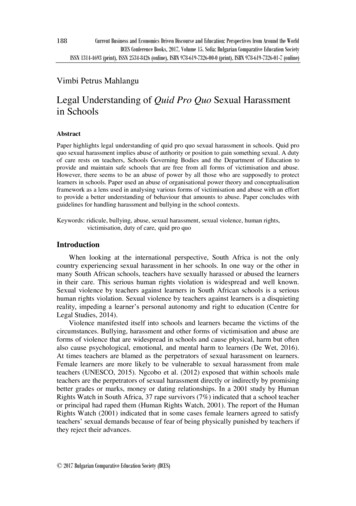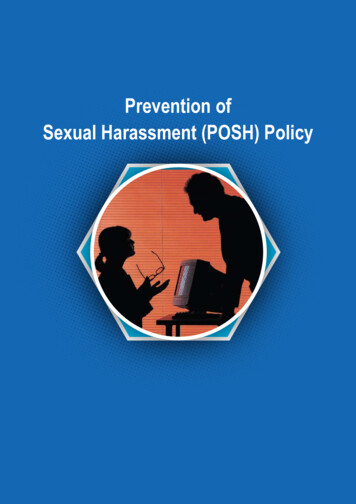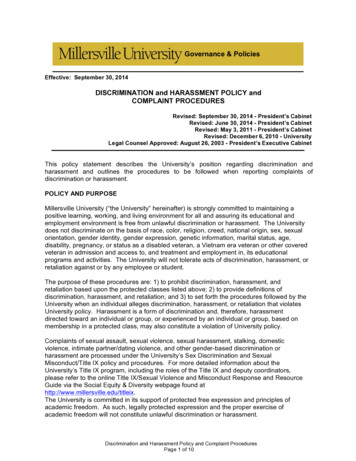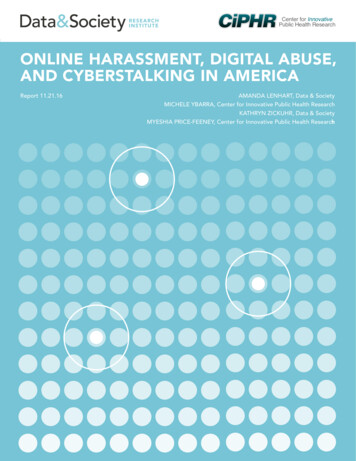
Transcription
Center for InnovativePublic Health ResearchONLINE HARASSMENT, DIGITAL ABUSE,AND CYBERSTALKING IN AMERICAReport 11.21.16AMANDA LENHART, Data & SocietyMICHELE YBARRA, Center for Innovative Public Health ResearchKATHRYN ZICKUHR, Data & SocietyMYESHIA PRICE-FEENEY, Center for Innovative Public Health Research
Online Harassment, Digital Abuse, and Cyberstalking in AmericaSummary of FindingsThe internet and digital tools play an increasingly central role in how Americans engage with their communities:How they find and share information; how they connect with their friends, family, and professional networks; howthey entertain themselves; how they seek answers to sensitive questions; how they learn about—and access—the world around them. The internet is built on the ideal of the free flow of information, but it is also built on theideal of free-flowing discourse.However, one persistent challenge to this ideal has been online harassment and abuse—unwanted contact thatis used to create an intimidating, annoying, frightening, or even hostile environment for the victim and that usesdigital means to reach the target. As with their traditional expressions, online harassment and abuse can affectmany aspects of our digital lives. Even those who do not experience online harassment directly can see it andrespond to its effects; even the threat of harassment can suppress the voices of many of our citizens.In order to explore these issues and the ways that online environments affect our experiences online, this reportexamines American teens’ and adults’ experiences with witnessing, experiencing, and responding to theaftermath of online harassment and abuse. Its findings are based on the results of a nationally representativesurvey of 3,002 Americans 15 and older conducted from May 17th through July 31st, 2016. Respondents werecontacted by landline and cell phone, and interviews were conducted in English and Spanish.47% of internet users have experienced online harassment or abuseIn order to examine the types of harassment and abuse that Americans have personally experienced, weasked internet users about 20 harassing behaviors over the course of the survey. Overall, almost half (47%)of Americans have personally experienced one of the harassing behaviors we asked about. The types ofharassing behaviors we studied fall into three broad categories: Direct harassment refers to things that people do directly to one another. Examples include: being calledoffensive names, being threatened physically, and being stalked. 36% of internet users have experiencedthis type of harassment. Invasion of privacy refers to harms done to the victim through the unauthorized access to and exposure orspreading of information beyond the owner’s control. Experiences include: being hacked, having informationabout or images of the person exposed online without their permission, being impersonated, beingmonitored, and being tracked online. 30% of internet users have experienced this type of harassment. Denial of access occurs when someone uses the features of the technology or platform to harm the victim,usually by preventing access to essential digital tools or platforms. Examples include: sending a very largenumber of unwanted messages, rendering the account unusable; misuse of reporting tools so that theperson is blocked from using a platform; and technical attacks that overwhelm a device, site, server orplatform and prevent access to it. 17% of internet users have experienced this type of harassment.Overall, almost three-quarters (72%) of American internet users have witnessed online harassment orabuse, and almost half (47%) of Americans have personally experienced one of the harassing behaviorswe asked about.www.datasociety.net http://innovativepublichealth.org3
Men and women are equally likely to face harassment, but womenexperience a wider variety of online abuse, including more serious violations.Young people and sexual minorities are also more likely to experience onlineharassment or abuse—and more likely to be affected by itA common theme throughout our findings is that young people under age 30 and sexual minorities(respondents who identified as lesbian, gay, or bisexual) were generally more likely to witness and/or experienceonline harassment or abuse. Black, sexual minority, and young Americans—especially young women—are also less likely than others to say that people are mostly kind to each other online, and more likely tosay they self-censor what they post online in order to avoid harassment.Men are substantially less likely than women to describe what theyexperienced as harassmentInternet users who have experienced harassing behaviors differ as to whether they think their experienceconstitutes ‘harassment’ or not. We found that women who have experienced the behaviors we asked aboutwere substantially more likely than men who have experienced the same behaviors to say that they thoughttheir experience constituted ‘harassment or abuse’ (53% of women who experienced harassing behaviorsvs. 40% of men).Some behaviors were also more consistently considered ‘harassment’ by their targets. For instance, more thaneight in ten people who experienced cyberstalking, sexual harassment, or persistent harassment agreed thattheir experiences constituted ‘online harassment or abuse,’ while fewer than six in ten people who experiencedoffensive name-calling said the same.Women were more likely than men to be angry, worried, or scared as aresult of online harassment and abuseAmong those who did say that what they experienced was online harassment and abuse, women were almostthree times as likely as men to say the harassment made them feel scared, and twice as likely to say theharassment made them feel worried. Meanwhile, men who said they had been harassed were more likely thanwomen to say they were ‘not bothered’ by the experience. However, almost all of those who were‘not bothered’ also reported feeling another emotion (annoyed, worried, etc.) as well.27% of all American internet users self-censor their online postings out offear of online harassmentMore than a quarter of Americans (27%) say they have at some point decided not to post something online forfear of attracting harassment. While many internet users who have not encountered harassment still say theyhave self-censored to avoid potential harassment, people who have seen or experienced harassment online aremuch more likely to self-censor for this reason than those who have not.Looking at men and women of different age groups, we find that younger women are most likely to self-censorto avoid potential online harassment: 41% of women ages 15 to 29 self-censor, compared with 33% of men ofthe same age group and 24% of internet users ages 30 and older (men and women).4Data & Society Research Institute Center for Innovative Public Research
Online Harassment, Digital Abuse, and Cyberstalking in AmericaFour in ten young women say they have self-censoredto avoid harassment onlineAmong all internet users, the % in each group who say they havedecided not to post something online because they were worriedthey would be harassedMenWomen413323Ages 15-2924Ages 30 Source: Data & Society / CiPHR Measuring Cyberabuse Survey, May 17- July31, 2016. Interviews were conducted in English and Spanish(total n 3,002 U.S. internet users age 15 and older).72% of internet users have witnessed at least one harassing behavior onlineAlmost three-quarters (72%) of internet users have witnessed online harassment. The most pronounced differences areby age and sexual identity: Internet users under age 30 and those who identify as lesbian, gay, or bisexual are more likelyto witness all the core harassment behaviors we asked about. Black internet users are also more likely than White internetusers to have witnessed online harassment.In addition, the type of harassment Americans see can vary by subgroup. For example, although men and women are equallylikely to see online harassment overall, women are more likely than men to have seen certain behaviors, such as cyberstalking.A majority of witnesses have responded to harassment they sawMany witnesses take steps to support, report, and stand up for the targets of the harassment they see.Overall, 65% of those who witnessed online harassment reported taking at least one of these three actions: 45% of witnesses said something to the person targeted by the aggressor. 40% said something to the aggressor. 38% said they reported the behavior through the reporting tools available on the online platform where it took place.More than four in ten victims of online harassment have changed contact informationto escape their abuseWe asked internet users who have experienced online harassment and abuse what, if any, measures they have taken toprotect themselves from further harassment. Taken together, 65% of victims of online harassment have used at least oneof these types of protective strategies: 43% changed their contact information by changing their email address or phone number, or by creating a new socialmedia profile under a different name. 33% asked for help from a friend or family member, law enforcement, or domestic violence resources. 27% reported or flagged content that was posted about them without their permission. 26% disconnected from online networks and devices by abandoning social media, the internet, or their cell phone.www.datasociety.net http://innovativepublichealth.org5
65% of victims of online harassment have used at least one protective strategyAmong victims of online harassment, the % who say they have done the following things to protectthemselves from online harassment43% changed contact informationChanged your email address or telephonenumber36Created a new social media profile under adifferent name33% asked for help2133% asked for helpAsked a friend or family member for help26Gotten a restraining order or protection order11Gotten help from a domestic violence centerhotline, or website627% reported content27% reported contentReported or flagged content that was postedabout you on a website without your permission2726% disconnected from online networksdevices or devicesStopped using social media21Stopped going onlineStopped using your cell phone134Source: Data & Society / CiPHR Measuring Cyberabuse Survey, May 17- July 31, 2016.Interviews were conducted in English and Spanish (total n 3,002 U.S. internet usersage 15 and older including n 673 victims of online harassment).Many victims disconnect from support networks and information asa side effect of online harassment and abuseOnline harassment and abuse can cause victims to experience increased isolation or disconnection from theircommunities, whether because of the strain the harassment has put on their close relationships, or becausetheir harassment has made them feel more cut off from avenues for communication and information-seeking.We found that 40% of victims say they experienced at least one of these types of isolation ordisconnectedness due to the online harassment they experienced: 27% of victims experienced trouble in a relationship or friendship because of something that was postedabout them online. 20% had to shut down an online account or profile because of online harassment or abuse. 13% of victims felt less connected to information and 13% felt less connected to friends or familybecause their cell phone or internet use was limited because of harassment or abuse.6Data & Society Research Institute Center for Innovative Public Research
Online Harassment, Digital Abuse, and Cyberstalking in AmericaIn sum, nearly half of Americans have been digitally harassed, anda substantial majority have witnessed it. And, among those who haveseen or experienced online harassment, a large number have beennegatively affected by the experienceThis report shows that overall, about half of Americans have experienced online harassment and about half have not.At the same time, a substantial majority have seen harassment perpetrated by others online. The presence of onlineharassment and abuse can affect our sense of the tenor and climate of the internet as a place for civic discourse andconversation, as well as the health and well-being of those who are targeted for harassment. Just as with other spacesand places that we need to navigate each day, the internet is both a place for renewal, rejuvenation, and support; andfor abuse and harm. Our findings suggest that we must collectively work to combat online harassment if we want tosee the internet live up to its potential.AcknowledgementsThis report was made possible by a grant from the Digital Trust Foundation. The authors would like to thank theFoundation for their support of this project.About Data & SocietyData & Society is a research institute in New York City that is focused on social, cultural, and ethical issues arising fromdata-centric technological development. To provide frameworks that can help address emergent tensions, D&S iscommitted to identifying issues at the intersection of technology and society, providing research that can groundpublic debates, and building a network of researchers and practitioners that can offer insight and direction. To advancepublic understanding of the issues, D&S brings together diverse constituencies, hosts events, does directed research,creates policy frameworks, and builds demonstration projects that grapple with the challenges and opportunities of adata-saturated world.About Center for Innovative Public Health Research (CiPHR)The Center for Innovative Public Health Research, also known as CiPHR, examines the impact that technology has onhealth and how it can be used to affect health. We have developed programs to reduce HIV transmission, increasesmoking cessation, and provide supportive resources for youth experiencing cyberbullying and people with depression.CiPHR is a non-profit, public health research incubator founded under the previous name, Internet Solutions for Kids, Inc.(ISK). Our vision is to promote positive human development through the creation and implementation of innovative andunique technology-based research and health education programs. Public health is ever evolving and so are we.About the Digital Trust FoundationThe Digital Trust Foundation funds projects that promote online privacy, safety, and security. Established through aclass action lawsuit settlement, the foundation has committed approximately 6.7 million in grants in 2014 and 2015.The Digital Trust Foundation is no longer granting and not accepting new applications.www.datasociety.net http://innovativepublichealth.org7
IntroductionAs digital devices become ever more valuable tools for interpersonal communication and connection, they havealso become potential avenues through which harassment and abuse can be perpetrated. Many traditionalforms of harassment and abuse can be replicated online, and conventional forms of abuse—stalking, sexualharassment, discrimination, defamation, bullying, intimate partner violence, etc.—have all found digital expressions. As a result, various types of online discussion spaces, from news organizations to social media sites, havestruggled with how to encourage open discussion on their platforms without enabling cybebuse on their users.At the same time, the connectivity of networked spaces has cultivated new forms of harassment and abuse thatprimarily take place online. Both celebrities and non-celebrities alike have had their sensitive photos hackedand exposed online, and state legislatures across the country are wrestling with “revenge porn” laws to addressthis technologically-mediated form of harassment.1 As digital tools become more interwoven into Americans’personal and professional lives, understanding the spread and impact of cyberabuse is of increasing importanceto researchers, policymakers, businesses, and consumers.Defining online harassment and abuseHarassment can encompass a wide range of unwanted contact that is used to create an intimidating, annoying,frightening, or even hostile environment for the victim.2 Online harassment is generally recognized as referringto this type of negative and unwanted contact using digital means. Online harassment can be a brief occurrenceor a sustained campaign of abuse and attacks;3 the perpetrator (or perpetrators) might be intimately known tothe victim, or a stranger in another state or country. Online harassment is defined less by the specific behaviorthan its intended effect on and the way it is experienced by its target.While some forms of online harassment are quite similar to their “offline” equivalents, the internet can makeother forms of harassment easier to accomplish.4,5 In terms of cyberstalking, for instance, stalkers can monitorand contact their victims through a number of digital channels. Digital tools also allow for new types ofharassment that were either not previously possible or take on a fundamentally different character in an onlinecontext. As danah boyd has outlined, certain characteristics of networked online spaces change the dynamicsof interaction on these platforms. For example, the ability to post comments anonymously versus having to takeownership of one’s ideas can affect the culture and context of the online space. Moreover, the persistence andsearchability of online environments means that many forms of online harassment can remain online indefinitely,accessible and connected with the victim. Meanwhile, the replicability and scalability of networked spaces canmake it easier for strangers to join in on the abuse.6,71. As of November 2016, 34 states and the District of Columbia have passed legislation relating to non-consensual image sharing or “revenge porn.”“34 States DC Have Revenge Porn Laws.” Cyber Civil Rights Initiative. /.2. Examples: EEOC, University of Michigan; Cyberbullying.org3. Our definition departs from the legal definition in the legal definition requires the abuse to be “systematic and/or continued.” We asked aboutwhether respondents have ever experienced these things, but due to space constraints did not ask follow-up questions about frequency or amount—and people frequently don’t know who is harassing them in the first place.4. C. Southworth et al., “Intimate Partner Violence, Technology, and Stalking,” Violence Against Women 13, no. 8 (2007): 842-856.5. J. Strawhun, N. Adams, and M.T. Huss, “The Assessment of Cyberstalking: An Expanded Examination Including Social Networking, Attachment,Jealousy, and Anger in Relation to Violence and Abuse,” Violence and Victims 28, no. 4 (2013): 715-730.6. d. boyd, Taken Out of Context: American Teen Sociality in Networked Publics. ProQuest (2008).7. M. Duggan, “Online Harassment,” (Washington, DC: Pew Research Center, 2014).8Data & Society Research Institute Center for Innovative Public Research
Online Harassment, Digital Abuse, and Cyberstalking in AmericaThe existing landscape of research around online harassmentData from organizations as diverse as the Department of Justice, the Centers for Disease Control,the AP-NORC Center for Public Affairs Research/MTV, the National Network to End Domestic Violence,and the Pew Research Center have laid the groundwork for quantifying abuse, stalking, and onlineharassment. Their findings together show that technology has unequivocally changed the landscapeof harassment and abuse.Online harassment affects more and more people as the internet has become increasingly integratedwith—and central to—Americans’ personal and professional lives. Online harassment appears to be mostfrequently experienced by younger people, whose lives are highly intertwined with the internet and digitaltools: Roughly 70% of young adults and 40% of adults have experienced online harassment or abuse.8In addition, 16% of U.S. women and 5% of men have been stalked,9 a quarter to over three-quarters ofwhom may have been cyberstalked.10,11 Previous research shows that most commonly utilized channelsfor cyberstalking appear to be emails, text messages, calls, and voicemails.12,13Research suggests that women and racial/ethnic minorities —particularly women who also identify with aracial/ethnic minority group—are most frequently targeted for certain types of online harassment, as aresexual and gender minority adolescents.14,15 Men also experience online abuse, but may be less likely tolabel it as such, and less likely to have their experiences seen as abuse by others.Online harassment can have serious effects on the lives of its victims. Over half (53%) of young people whohave experienced online harassment report their experience to be deeply upsetting, and 37% of adultswho experienced severe online harassment describe being “extremely” or “very” upset by it.16,17 Onlineharassment is also associated with psychological harms. Adolescent victims of digital abuse are more likelyto show signs of depression than those who have never been victimized online. They are also more likelyto require mental health treatment and to have considered suicide within the previous year.18,19Additionally, as with abuse in other realms, digital abuse can lead to withdrawal by the victim, narrowingtheir world and reducing engagement with family and friends. Among adult victims, digital abuse can alsoharm the victim’s career through damage to their online reputation or by forcing them to disengage fromplatforms and networks necessary for their professional advancement. 208. Ibid.9. M. C. Black et al., “The National Intimate Partner and Sexual Violence Survey (NISVS): 2010 Summary Report.” Atlanta, GA: National Center for InjuryPrevention and Control, Centers for Disease Control and Prevention 75 (2011).10. Ibid.11. K. Baum et al., “National Crime Victimization Survey: Stalking Victimization in the United States,” (Washington, DC: U.S. Department of Justice,Office of Justice Programs, 2009).12. Black et al.13. Baum et al.14 Duggan.15. GLSEN, CiPHR, & CCRC. “Out online: The experiences of lesbian, gay, bisexual and transgender youth on the Internet.” New York: GLSEN (2013).16. Duggan.17. Executive Summary: 2011 AP-MTV Digital Abuse Study. The Associated Press, MTV (2011)18. K.J. Mitchell, M. Ybarra, D. Finkelhor, “The Relative Importance of Online Victimization in Understanding Depression, Delinquency, and SubstanceUse.”Child Maltreatment 12, no. 4 (2007): 314-24.19. AP-MTV Digital Abuse Study.20. D.K. Citron, Hate Crimes in Cyberspace. Cambridge, MA: Harvard University Press, 2014.www.datasociety.net http://innovativepublichealth.org9
The scope of this reportBecause of the potential impact of online harassment and the rapidly changing nature of digital technologies,it is important to quantify how widespread these behaviors are and to understand how they impact internetusers of all ages. It is in this complex landscape of data, awareness, and challenge that we conducted this study.This report aims to extend the existing research by providing a rigorous and comprehensive picture of theprevalence of technologically-mediated forms of harassment, abuse, and stalking in a nationally-representativesurvey. The study begins by exploring the types of harassment and abuse internet users say they have witnessedin online spaces, and what, if any, types of actions they took in response. This study also examines if simplywitnessing online harassment, with no personal experience, and the perceived threat of it leads to self-censoringin online spaces among internet users. We also asked internet users about their own experiences with onlineharassment, abuse, and cyberstalking, and how those experiences made them feel. We then asked victims aboutpotential negative consequences they may have experienced as a result of their online harassment or abusein addition to any privacy practices they have used to protect themselves from harassment.About this surveyThe data in this report were collected through a nationally representative telephone survey of 3,002 Americaninternet users ages 15 and older. The survey was fielded from May 17 to July 31, 2016, and was conducted on cellphones and landlines. Interviews were administered by Princeton Data Source in English and in Spanish. Statisticalresults are weighted to correct known demographic discrepancies. The margin of sampling error for the completeset of weighted data is 2.0 percentage points. For more detail, please see the separate Methods section availableat http://www.datasociety.net/pubs/oh/methods.pdf.The survey was conducted by Princeton Survey Research Associates International (PSRAI) and funded by the DigitalTrust Foundation. Survey design and data analysis were executed by staff at the Data & Society Research Instituteand the Center for Innovative Public Health Research.A note on terms used in this reportThroughout the report, the terms “Americans,” “respondents,” or “internet users” are used to refer tointernet-using Americans ages 15 and older. The term “youth” refers to teens and adults ages 15 to 29,and the term “young adults” refers to those ages 18 to 29. In this study, we use the terms “LGB” or “sexualminorities” to refer to respondents who self-identified as lesbian, gay, bisexual, or “other” when asked theirsexual identity. The survey did not include a question about gender identity, so this report cannot examineexperiences of transgender Americans specifically.10Data & Society Research Institute Center for Innovative Public Research
Online Harassment, Digital Abuse, and Cyberstalking in AmericaChapter 1. Witnessing Online HarassmentSome 87% of Americans go online, and 68% have a smartphone that connects to the internet.1 As thesedevices, and the platforms and networks that use them, become more integrated into our daily lives, theyprovide important spaces for interacting with others and learning new things. As with all places and arenaswhere people come together, there is the potential for positive and supportive interactions, and also fornegative and harmful experiences online. In order for online spaces to facilitate the free flow of informationand the exchange of ideas, everyone must feel comfortable inhabiting and interacting in those spaces.To better understand these experiences, we need to know more about the tenor of social life online: Do peoplethink of the internet as a space for mostly positive or negative interactions? What types of harassing behaviorsdo they see? Does witnessing harassment or abuse affect how people think about the online environment?In this chapter, we explore individuals’ experiences with witnessing online harassment: if they have everwitnessed online harassment and what form it has taken, what they did as a result of having witnessed it, andhow it made them feel about the kindness of online spaces more generally.The harassment that Americans see onlineWitnessing specific types of abuse towards another person onlineWe asked internet users about whether they had ever witnessed several types of online harassment, rangingfrom seeing someone being called offensive names to seeing someone being stalked. Almost three in four(72%) internet users have witnessed at least one of the seven behaviors asked, and one in twenty (5%) havewitnessed all of them. This is in line with previous research by the Pew Research Center, which found that 73%of internet users have witnessed one of six harassing activities.21. 87% of American adults use the internet as of January 2014. “Internet Use Over Time.” Pew Research Center: Internet, Science & Tech, January 2, t-use/internet-use-over-time/. 68% of American adults own a smartphone as of July 2015. “Device Ownership Over Time.” Pew Research Center: Internet, Science & Tech, November 13, 2013. e-ownership/.2. “ Online Harassment.” Pew Research Center: Internet, Science & Tech, October 22, 2014. sment/.www.datasociety.net http://innovativepublichealth.org11
72% of internet users have witnessed at least one harassing behavior onlineAmong all internet users, the % who say they have ever witnessed any of the following behaviorsdirected at a particular person onlineSomeone being called offensive names62Someone trying to embarrassanother person on purpose61Someone being physically threatened33A romantic partner purposefully hurting theirpartner emotionally or psychologically28Someone being sexually harassed26Someone being harassed online overa long period of time20Someone being stalked19Number of harassment or abuse behaviors witnessed onlineAmong all internet users281511None12133114957657 (all)Source: Data & Society / CiPHR Measuring Cyberabuse Survey, May 17- July 31, 2016.Interviews were conducted in English and Spanish (total n 3,002 U.S. internet users age 15 and older).Being called offensive names and being embarrassed were by far the most common forms of digitalharassment witnessed by Americans. They were reported twice as often as the other five forms queried.Seeing someone being stalked or someone being harassed for an extended period were the least commonforms reported, although even here, one in five Americans said they had seen someone else online be targetedfor this type of abuse.The most pronounced differences in witnessing harassment and abuse online are by age and sexual identity:Younger internet users and those who identify as lesbian, gay, or bisexual (LGB) are most likely to witness eachform of online harassment discussed in this study. Women and Black internet users are also more likely thanmen and White internet users to witness certain forms of harassment.12Data & Society Research Institute Center for Innovative Public Research
Online Harassment, Digital Abuse, and Cyberstalking in AmericaYounger internet users are more lik
65% of victims of online harassment have used at least one protective strategy Among victims of online harassment, the % who say they have done the following things to protect themselves from online harassment 36 21 26 11 6 27 21 13 4 Changed your email address or telephone number Created a new social media profile under a different name
